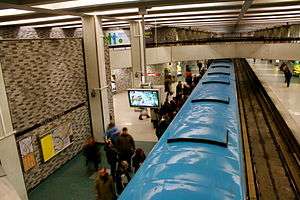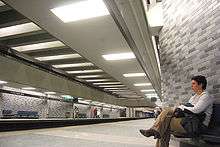Place-des-Arts station
Place-des-Arts station is a Montreal Metro station in the borough of Ville-Marie, Montreal, Quebec, Canada.[3] It is operated by the Société de transport de Montréal (STM) and serves the Green Line. The station opened on October 14, 1966, as part of the original network of the Metro.
Place-des-Arts | |||||||||||
|---|---|---|---|---|---|---|---|---|---|---|---|
 | |||||||||||
| Location | 2020, rue de Bleury, Montreal Quebec, Canada | ||||||||||
| Coordinates | 45°30′29″N 73°34′07″W | ||||||||||
| Operated by | Société de transport de Montréal | ||||||||||
| Connections | Société de transport de Montréal | ||||||||||
| Construction | |||||||||||
| Depth | 11.6 metres (38 feet 1 inch), 47th deepest | ||||||||||
| Architect | David, Boulva, et Clève | ||||||||||
| History | |||||||||||
| Opened | 14 October 1966 | ||||||||||
| Traffic | |||||||||||
| Passengers (2019[1][2]) | 8,145,797 | ||||||||||
| Rank | 8 of 68 | ||||||||||
| Services | |||||||||||
| |||||||||||
Overview

Designed by David, Boulva, et Cleve, it is a normal side platform station built in open cut under boul. De Maisonneuve, with two ticket halls joined by corridors that surround and overlook the platforms. The eastern mezzanine includes staircases with one-way exit-only turnstiles. The station is joined by underground city to Place des Arts and Université du Québec à Montréal, and has additional four street-level exits.
The station's walls are coved in light-blue bricks in a zig-zag layout.
The station is equipped with the MétroVision information screens which displays news, commercials, and the time until the next train arrives.
The station has 4 entrances:
- 1555, rue Jeanne-Mance
- 2020, rue de Bleury
- 1990, rue de Bleury
- 150, rue Ontario
Architecture and art

The station features art by Frédéric Back: a massive stained glass mural entitled L'histoire de la musique à Montréal ("history of music in Montreal"). The work is composed of thousands of layered pieces of glass backlit by 105 lighting tubes and supported by a tonne of steel. The glass surface is rippled, causing the brilliant colours to shimmer ethereally. The work was originally intended to be an homage to four important Quebec musical artists: the composers Calixa Lavallée, Guillaume Couture, and Alexis Contant, and soprano Dame Emma Albani. Unveiled on December 20, 1967, this stained glass was the first work of art to be commissioned for the Metro system. In 2008 the lighting system was completely renovated by the lighting artist Axel Morgenthaler.
The second work of art is a hand-glazed ceramic mosaic by the artist Saskia Siebrand, installed in 2005. It contains tiles of over 300 colours, all custom hand-glazed.
This architectural composition made of perforated aluminum panels was added to conceal a telecommunications room that had been added over the station's western tunnel opening. Before this work was added, the Montréal métro featured only one mosaic, the one by Gabriel Bastien and Andrea Vau at Sherbrooke station.
Origin of the name
This station is named for the Place des Arts cultural complex. Opened in 1963, this complex includes five concert halls, including the largest multipurpose concert hall in Canada, and an art museum.
Connecting bus routes
| Société de transport de Montréal |
|---|
| Route |
Nearby points of interest
Connected via the underground city
- UQAM (pavillons Président-Kennedy, Chimie, Biochimie, and Arts IV)
- Place des Arts
- Musée d'art contemporain de Montréal
- Complexe Desjardins
- Hydro-Québec Building
- Place-d'Armes Metro station and points south
Other
- Quartier des Spectacles
- Église du Gesù
- Cinéma Imperial
References
- Société de transport de Montréal (2020-05-21). Entrants de toutes les stations de métro en 2019 (Report) – via Access to Information Act request, reference no. 0308.2020.091.
- Société de transport de Montréal (2019-08-08). Achalandage du métro mensuel, station par station (Report) – via Access to Information Act request, reference no. 0308.2019.197.
- Place-des-Arts Metro Station
- "Latest bus news for September". Société de transport de Montréal. Retrieved 2019-08-22.
External links
| Wikimedia Commons has media related to Place-des-Arts (Montreal Metro). |
- Place-des-Arts Metro - official site
- Montreal by Metro, metrodemontreal.com - photos, information, and trivia
- 2011 STM System Map
- 2011 Downtown System Map
- Metro Map
